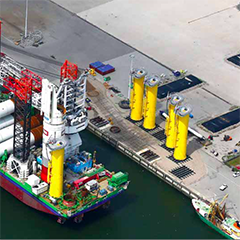Offshore terminals are the most important interfaces during the construction of
wind farms off the coasts of the North and Baltic Seas. Many wind farms have been created in recent years and more are already in the planning stages. The Hamburg-based company Buss Port Logistics (Buss) recognised the opportunities early on, and with their own Orange Blue Terminal (OBT) in the Dutch port of Eemshaven, they developed the “Offshore” sector. Martin Schulz, Head of Offshore Logistics at Buss, offers PES a glimpse behind the scenes: from the initial planning of a terminal to the completed offshore project.
From sandy desert to a heavy cargo terminal
The Eemshaven offshore terminal was already an important hub for many projects in the North Sea. However, in order to bring ashore the massive components, to put them in intermediate storage, to perform the pre-installation and to ship them back out, extensive construction measures were required at the terminal, situated on the southwestern bank of the Ems estuary.
“When Buss came to visit the future terminal in Eemshaven for the first time, it looked more like a sandy desert, without even a quay wall in place,” explains Schulz, adding: “The management team was quite optimistic however. This way, Buss was able to develop the area from scratch, entirely in line with its own ideas and in a manner suitable for offshore activities.”



























